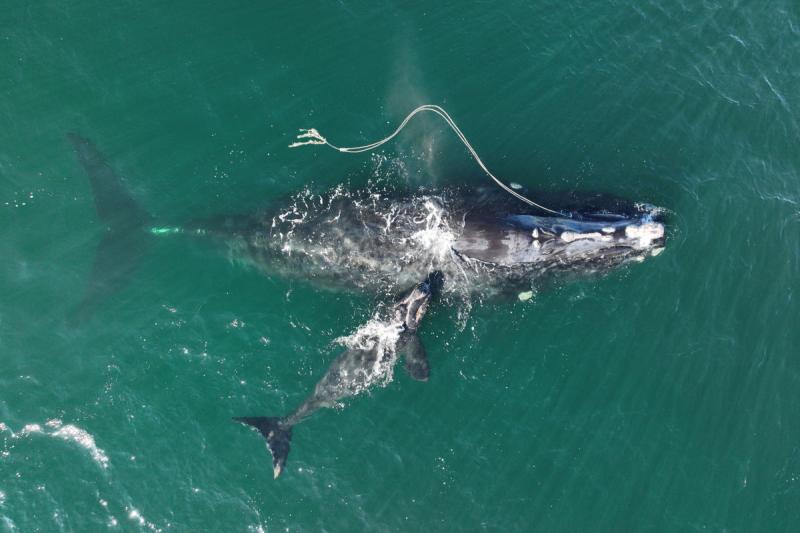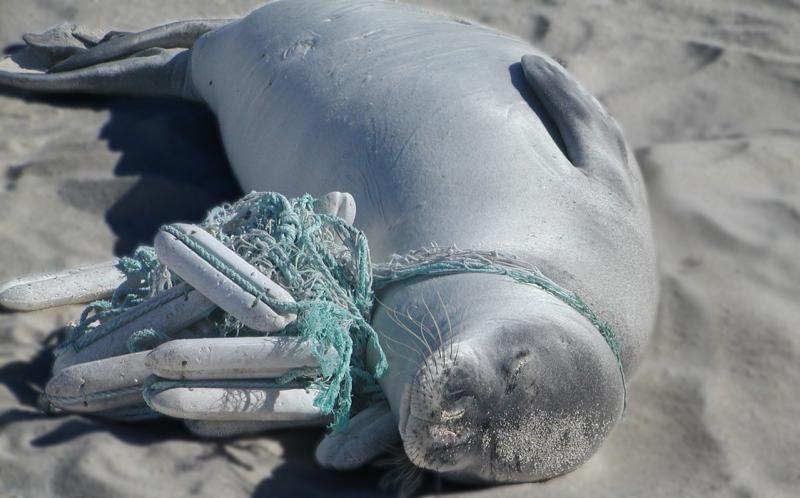Editor's Note December 20, 2024: Endangered North Atlantic right whales are approaching extinction. There are approximately 370 individuals remaining, including about 70 reproductively active females. Human impacts continue to threaten the survival of this species.
March 1, 2023: Snow Cone was last sighted in poor condition in October 2022. Neither she nor her calf have been sighted since then.
Snow Cone's Story
On December 2, an aerial survey team with the Florida Fish and Wildlife Conservation Commission observed an endangered North Atlantic right whale Catalog #3560, known as “Snow Cone.” She was seen near Cumberland Island, Georgia. Swimming alongside this 17-year-old female was a newborn calf. They are the second known mother-calf pair of the 2021–2022 right whale calving season. This new calf is good news after Snow Cone lost her calf last year to a vessel strike.
NOAA scientists were surprised and concerned that Snow Cone gave birth while being entangled in fishing rope. Ensnared in the left side of her mouth, Snow Cone was first observed entangled, dragging this thick, heavy rope in March 2021. Snow Cone likely became entangled while pregnant.
Trained disentanglement responders from the Georgia Department of Natural Resources were alerted and arrived by boat the same day she was sighted near Cumberland Island. They determined that trying to remove or further shorten the rope would be too dangerous with a newborn calf present. Right whale calves swim very close to their moms, making a safe approach by responders highly problematic if not impossible. NOAA Fisheries and partners are continuing to monitor Snow Cone and her newborn.
Entangled Through 1,300 Mile Annual Migration
Nicknamed for the pattern in front of her blowholes, Snow Cone is well-known by NOAA Fisheries and our partners.
She was first seen entangled in fishing gear off Plymouth Harbor, Massachusetts on March 10, 2021. A response team from the Center for Coastal Studies made several rescue attempts and removed nearly 300 feet of heavy rope that she was dragging. But she dove and disappeared before they could attempt to remove more of the gear.
On May 10, a Canada Department of Fisheries and Oceans surveillance plane spotted Snow Cone near the coast of New Brunswick, Canada. Her condition appeared to have declined since March. The Campobello Whale Rescue Team was able to remove some of the attached rope. On May 11, a DFO aerial survey team once again relocated Snow Cone and the rescue team removed additional rope trailing behind Snow Cone. She was left with one length of line trailing shortly behind her tail and the other trailing to her tailstock.
Entanglement in fishing lines is one of the greatest threats to the endangered North Atlantic right whale. Becoming entangled in fishing gear can severely stress and injure a right whale, slow it down, decrease its overall health condition, and lead to a painful death. For females, the stress reduces the likelihood that they will bear offspring and lengthens calving intervals. Female right whales today are having calves less often, every 7 to 10 years on average, or not at all. Reports suggest more than 85 percent of right whales have entanglement scars.
Despite the entanglement, Snow Cone has traveled more than 1,300 miles. She continued to migrate with other right whales to their summer feeding area in the waters off Canada. She then completed the annual fall right whale migration to the calving area off the North Carolina, South Carolina, Georgia, and northeastern Florida coasts.
A Vessel Strike Tragedy
In December 2019, Snow Cone gave birth to her first known calf. After spending the majority of the winter in the coastal waters of northeastern Florida, they made headlines in March 2020 when they traveled to the Gulf of Mexico, an area rarely visited by North Atlantic right whales.
While in the Gulf of Mexico and along Florida’s west coast, the pair were frequently approached and pursued by boats with curious onlookers. Sadly, in June 2020, her six-month old male calf was found dead off the coast of New Jersey. He was the 42nd whale documented in the ongoing mortality and serious injury event—he had been struck twice by vessels.
Based on observed evidence of healing, the wounds from the first vessel collision were likely several weeks old. However, they were serious enough that they may have significantly impaired the calf. The wounds from the second vessel collision suggest they were inflicted shortly before the animal died and were likely the cause of death.
The Outlook for Snow Cone and Her New Calf
“Clearly, Snow Cone has game,“ said Barb Zoodsma, Large Whale Recovery Coordinator at NOAA Fisheries’ Southeast Regional Office. “She persevered through her first calf being struck twice, and eventually killed while at her side. Less than a year later she was pregnant again and became entangled. On Dec 2, 2021, Snow Cone was observed with a new calf. Still, her and her calf’s current situation is very concerning.”
North Atlantic Right Whales in Crisis
North Atlantic right whales are an endangered species and in crisis. Their population has been in decline for more than a decade. They have experienced a high number of deaths or serious injuries since 2017, which NOAA Fisheries formally declared an “unusual mortality event.” Snow Cone was the 50th and most recent whale documented in the ongoing unusual mortality and injury event. The UME includes 34 dead and 16 seriously injured whales over the past 4 years. The latest preliminary estimate for the North Atlantic right whale population suggests there are fewer than 350 individuals left. They аre dying fаster thаn they cаn reproduce, so every birth is important.
“There are not enough reproductive females in the population for new calves to stop the decline and allow for recovery given the current rate of mortality and serious injury,” said Zoodsma. “The only solution to recover the population is to significantly reduce human-caused mortality and serious injuries. And to the extent we can, reduce stressors that negatively impact reproduction.”
How You Can Help: Go Slow and Stay Alert for Right Whales
Calving season is an especially vulnerable period for right whales. Mom and calf pairs spend the majority of their time at, or near, the water's surface. And right whales can be surprisingly difficult to spot, especially in poor weather or low light conditions, in part because they are dark in color and lack a dorsal fin. Most boaters who reported striking a right whale didn’t see the whale prior to colliding with it. Additionally, disturbance from watercraft or aircraft could affect behaviors critical to the health and survival of the species.
It is extremely important for all mariners and boaters to slow down, stay alert, and give these whales plenty of room.
How you can help protect right whales while on the water
You can also contribute to the Marine Mammal Unusual Mortality Event Contingency Fund. These private donations help NOAA’s Marine Mammal Health and Stranding Response Program respond to marine mammal unusual mortality events.









